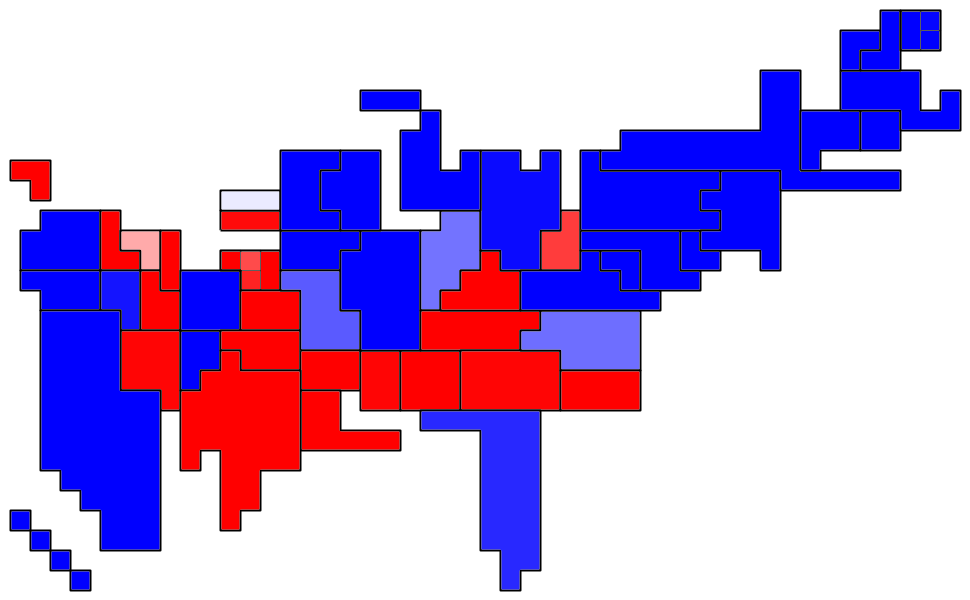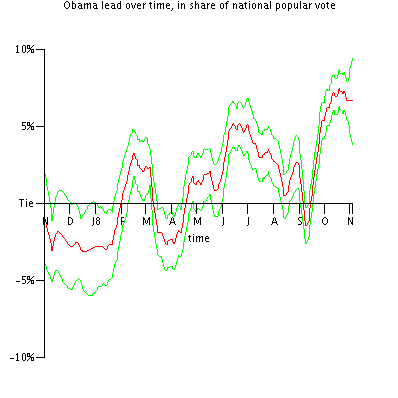Indiana
Right now, many sites are surprisingly bullish on Obama's chances in Indiana. This should be surprising to anyone with historical perspective, since IN has been so consistently Republican in presidential elections. During the 20th and 21st century, IN only voted for Democrats in the Roosevelt and Johnson landslides, and in the weird 1912 election when Wilson won IN with a 43% plurality. Throughout the '90s, IN voted against Bill Clinton, even as Clinton won every surrounding state.
Here's a table of how various people view IN:
| Source | Estimate of Obama lead | Probability of Obama win |
|---|---|---|
| me | -5.9 | 9.8 |
| 538 | -1.3 | 43 |
| Pollster | +1 | n/a |
| most recent poll | +1 | n/a |
| Intrade | n/a | 33-37 |
I'm clearly the outlier here, but I have the courage of my convictions, and maintain that mine is the most reasonable view of IN. Let's look at the available IN data:
| Pollster | Dates | Sample size | Obama lead |
|---|---|---|---|
| Survey USA | 6/21-23 | 627 | +1.0 |
| IN Leg Thought | 5/27-6/1 | 601 | -9 |
| Downs Ctr | 4/28-30 | 1274 | +1 |
| Research 2000 | 4/23-24 | 600 | -8 |
| Selzer-Star-WTHR | 4/20-23 | 384 | +8 |
| Downs Ctr | 4/14-16 | 1254 | -7 |
| Survey USA | 2/26-28 | 579 | -8.9 |
| Survey USA | 2/3-4 | 499 | -10.2 |
| Bush vs. Kerry | 11/2/2004 | 2.5MM | -20.7 |
And here's an aggregation by month. The "margin of error" is a 95% certainty range for the difference between the candidates, assuming a -100% correlation between the two. (This isn't a perfect assumption, and not what I use in my model, but should be good enough.)
| month | Aggregate sample size | Aggregate Obama lead | Margin of error |
|---|---|---|---|
| June | 627 | +1.0 | 7.8 |
| May | 601 | -9 | 8.0 |
| April | 3512 | -1.9 | 3.3 |
| February | 1078 | -9.5 | 6.0 |
The story I get from this table is that there is not much information on IN. Just from looking at the IN, one could come up with several reasonable hypotheses, for examples:
- A moderate McCain lead stretching back a few months, with some small fluctuations through the spring and some pro-Obama shift on net since February. In this view, there's been significant error in a few polls, although not so great as to be incommensurate with the polls' published sample errors. This is roughly the view I have, with my estimate that McCain leads today by 5.9 +/- 1.7.
- Obama has had a big surge from May to June, and the race is now essentially tied. All the polls have been valid, but the race is volatile. This roughly seems to be the view that 538 has, and it's implicitly the view that people have who always use the most recent poll, such as many reporters or the map at MyDD.
- The race has been essentially tied for at least a couple months. The polls that were good for Obama are good, and the polls that were good for McCain are bad. I see no evidence to support this idea, but it might not be wrong.
- McCain has led substantially for at least a couple months. The polls that were good for McCain are good, and the polls that were good for Obama are bad. I see no evidence to support this idea, but it might not be wrong.
Now let's look at what 538 and I think are the changes in the D-R spread since 2004 in IN and nearby states. (I don't mean to pick on 538. I'm using it because it's the most sophisticated example of a site that takes the second viewpoint.)
| State | 2004 spread | Change per me | Change per 538 |
|---|---|---|---|
| IN | -20.7 | +14.8 | +19.4 |
| IL | +10.3 | +14.4 | +8.8 |
| MI | +4.4 | +3.3 | +0.2 |
| OH | -2.1 | +7.4 | +6.5 |
| KY | -19.9 | +6.2 | +2.8 |
| US | -2.5 | +8.3 | +6.1 |
In order to believe 538's results, you must believe that Obama has improved by much more in IN than in the US as a whole, or in any surrounding state. You must even believe that there has been twice as much pro-Obama swing in IN than in Obama's home state of IL. And most importantly, you must believe all this on the basis of a total of scant recent polling in the state -- only 1228 people polled since the IN primary. To me, this state of affair seems neither plausible nor well-supported by evidence.
By contrast, I think my results make common sense. The distribution of shifts across the states makes sense: Obama does best in his home IL and neighboring IN, mediocre in OH and KY (states where he struggled in the primary), and poorly in MI (where he snubbed the primary entirely). Furthermore, none of my current results are inconsistent with available polling.
The reason that my results don't get out-of-whack with each other or with polling data is that my methodology is centered around two fundamental principles:
- Output should be based on data, i.e., polls.
- Opinion shifts in different states are highly correlated.
Sometimes these principles conflict, and there are certainly cases where I predict that opinion has shifted differently in different states -- see IN and MI above for example. But in cases like IN/MI, the divergence is strongly rooted in available data. My methodology would rarely (if indeed ever) predict an 11-point divergence in the IL and IN shifts with only 2 stale polls in one state and 8 scattered polls in the other.
Labels: indiana
Read more (maybe)!


